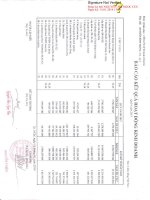TB co-infection in and around Khammam, Telangana, India - Trường Đại học Công nghiệp Thực phẩm Tp. Hồ Chí Minh
Bạn đang xem bản rút gọn của tài liệu. Xem và tải ngay bản đầy đủ của tài liệu tại đây (151.31 KB, 7 trang )
<span class='text_page_counter'>(1)</span><div class='page_container' data-page=1>
<i><b>Int.J.Curr.Microbiol.App.Sci </b></i><b>(2017)</b><i><b> 6</b></i><b>(11): 3698-3705 </b>
3698
<b>Original Research Article </b>
<b>A Study on HIV/TB Co-infection in and around Khammam, Telangana, India </b>
<b>Nella Harshini* and B. Anuradha </b>
Mamata Medical College, Rotary Nagar, Khammam, Telangana 507002, India
<i>*Corresponding author </i>
<i><b> </b></i> <i><b> </b></i><b>A B S T R A C T </b>
<i><b> </b></i>
<b>Introduction </b>
Tuberculosis is the most common
opportunistic infection and the major cause of
death in HIV positive patients all over the
world accounting for 40% of all infections
seen in individuals with HIV infection (Pape,
2004) It accounts for about 13% of deaths
among HIV positive patients worldwide
(Sharma <i>et al.,</i> 2004, 2005; Arora <i>et al.,</i> 1999;
Gothi <i>et al.,</i> 2004; Corbett <i>et al.,</i> 2003).
In HIV/TB co-infected individual, TB and
HIV potentiate one another, resulting in the
accelerated deterioration of immunological
functions and premature death of the
individual if untreated (Getahun <i>et al.,</i> 2010).
People living with HIV (PLHIV) are more
prone to tuberculosis infection as the virus
weakens the immune system (Dar es Salaam,
Tanzania, 2006) in many ways such as
disease progression to active TB, increasing
the risk of reactivation of latent TB. Chances
of TB infection also increase once exposed to
tubercle bacilli in PLHA (Sharma <i>et al.,</i> 2005;
Badri <i>et al.,</i> 2001).
Early and prompt diagnosis of infection and
management of tuberculosis leads to the
reduction of tuberculosis burden. However, in
HIV infected individuals, diagnosis may be
difficult as there is scanty sputum production,
<i>International Journal of Current Microbiology and Applied Sciences </i>
<i><b>ISSN: 2319-7706 Volume 6 Number 11 (2017) pp. 3698-3705 </b></i>
Journal homepage:
A Study on HIV/TB Co-infection in and Around Khammam, Telangana Tuberculosis is
the most common opportunistic infection and the major cause of death in HIV positive
patients. In India, the incidence of TB is about 40% in general population and about
25-30% extra cases are due to HIV infection. To study the demographical and clinical factors
associated among HIV/TB co-infected patients in and around Khammam. A
cross-sectional study was conducted among 107 HIV/TB co-infected patients attending ICTC
centre in the district hospital Khammam from July-November 2016. HIV/TB positive with
CBNAAT, all age groups, both genders were included in the study. 107 HIV patients were
found to be positive for TB by CBNAAT. Rifampicin resistance was detected in 10
patients (9.34%). 54(50.4%) were under pre-antiretroviral therapy and 46(42.9%) were
under antiretroviral therapy and others were 7(6.5%). 45(42.05%) patients with HIV/TB
co-infection showed CD4 count <200 cells/mm3, 32(29.9%) showed 200-349 cells/mm3,
and 6(5.6%) showed 350-500 cells/mm3 and remaining showed >500 cells/mm3.
Demographical characters were also considered. P value <0.05 was considered to be
significant. The major determinants of HIV/TB co-infection were identified to be low CD4
counts, ART and WHO clinical stages.
<b>K e y w o r d s </b>
HIV, TB,
Co-infection, CD4 count,
CBNAAT.
<i><b>Accepted: </b></i>
26 September 2017
<i><b>Available Online:</b></i>
10 November 2017
</div>
<span class='text_page_counter'>(2)</span><div class='page_container' data-page=2>
<i><b>Int.J.Curr.Microbiol.App.Sci </b></i><b>(2017)</b><i><b> 6</b></i><b>(11): 3698-3705 </b>
3699
lack of caseous necrosis resulting in less no.
of bacilli in sputum, and high incidence of
non-tubercular mycobacterial infection
(Dewan <i>et al.,</i> 2015). As a result, there is an
increase in smear negative tuberculosis and
unremarkable chest radiographs leading to
difficulties in reducing the tuberculosis
burden (Lucas <i>et al.,</i> 1994; Jones <i>et al.,</i> 1993).
Hence the sensitivity and specificity of
sputum microscopy are decreased in HIV
infected individuals (Dewan<i> et al.,</i> 2015). To
overcome these difficulties, sputum culture
and sensitivity can be used but it takes 4-8
weeks to get results and not suitable for
screening. This results in the delayed
initiation of treatment, increasing the risk of
transmission of tuberculosis in community
and also increases the spread to extra
pulmonary sites in the patient (Swaminathan
<i>et al.,</i> 2000).
CBNAAT, a polymerase chain reaction
(PCR) based method which targets rpoB gene
of mycobacterium, has been introduced
recently for detection of TB and also
rifampicin resistance. It is a specific,
automated, cartridge-based nucleic acid
amplification assay uses real-time PCR and
provides results within 100minutes. It targets
rpoB gene, a gene associated with rifampicin
resistance, by using 3 specific primers and 5
unique molecular probes. Hence it is highly
specific test for detection of TB and
rifampicin resistance (Swaminathan<i> et al.,</i>
2000).
Studies showed an estimate about 9% of all
TB cases in adults were prone to HIV
infection worldwide and 12% of the total
deaths from TB in the year 2000 was directly
associated with HIV/TB co-infection (Corbett
<i>et al.,</i>2003). The situation has become very
serious due to increased incidence of TB by
>6% per year (Corbett<i> et al.,</i> 2003).
In HIV prevalent countries, about 14-54% of
HIV infected people were undiagnosed with
TB prior to death whose autopsy studies have
shown disseminated TB (Haileyeus Getahun
<i>et al.,</i> 2007). In high burden TB countries,
studies showed that several demographic and
clinical factors are significantly associated
with HIV/TB co-infection (do Prado <i>et al.,</i>
2014; Kibert <i>et al.,</i> 2013; Liu <i>et al.,</i> 2015).
An estimate showed that 3.1 million deaths
occur annually due to HIV/TB co-infection in
South-east Asia (Joint United Nations
Programme on HIV/AIDS and WHO 2002.
AIDS Epidemic updates 2004.
UNAIDS/04.45E. Geneva: UNAIDS; 2004).
In India, the incidence of TB in general
population is estimated to be around 40%;
however, studies shown around 25-30% of
increased incidence of TB due to HIV
infection (Raviglione<i> et al.,</i> 1995, 2003).
As there is increased burden worldwide and
all over India, this study is taken up to know
the burden in and around Khammam. To
know the socio-demographic profile along
with CD4 count, Rifampicin resistance and
ART status in patients with HIV/TB
co-infection in our area.
<b>Materials and Methods </b>
A cross-sectional study was conducted among
107 HIV/TB co-infected patients attending
ICTC & ART centers in the Government
District General Hospital, Khammam from
July-November 2016 after obtaining
institutional ethical committee clearance.
HIV/TB co-infected patients of both genders
and all age groups and followed up in ART
clinic at district hospital, Khammam were
included in the study.
</div>
<span class='text_page_counter'>(3)</span><div class='page_container' data-page=3>
<i><b>Int.J.Curr.Microbiol.App.Sci </b></i><b>(2017)</b><i><b> 6</b></i><b>(11): 3698-3705 </b>
3700
positive individuals were excluded in the
study.
<b>Operational definitions used </b>
As per the national guidelines, all HIV
seropositive individuals were screened for TB
routinely.
The diagnostic method used in these patients
is CBNAAT which detects the tubercle bacilli
along with resistance to rifampicin.
<b>Results and Discussion </b>
Our study comprised a total no. of 107 HIV
seropositive and TB positive patients. Out of
107 individuals, 72(67.2%) were males and
35(32.7%) were females (Table 1). In one
study by Dewan <i>et al.,</i> showed that 76% were
males, 24% were females (Dewan<i> et al.,</i>
<i>JIACM </i>2015).
In other studies, it is observed that HIV/TB
co-infection in males was 75.3% (Kamath<i> et </i>
<i>al.,</i> 2013) and 82% (Patel<i> et al.,</i> 2011)
respectively which are correlating with our
study.
Our study included the individuals of age
group 10-60yrs with mean age of 35years.
Majority of HIV-TB coinfection is seen in
31-40years with 37(34.5%) followed by
34(31.7%) in the age group of 21-30years
(Table 1). Similar observations are seen in a
study which showed 76% belongs to age
group of 21-40 years (Patel<i> et al.,</i> 2011)
which shows that this is the age of high
sexuality and reproductive age.
In other study by Sandhya<i> et al.,</i> observed
that the most common age group affected was
21-40years (47.5%) than other age groups
(Sawant<i> et al.,</i> 2011).
The present study showed that HIV/TB
coinfection was high in married individuals
(87.8%) which indicates that heterosexual
transmission is common (Table 1). In one
study, Bernard J Ngwoki <i>et al.,</i> (2008)
observed that HIV/TB co-infection is more in
married individuals (50%). Other study by
Ramanchandran Kamat <i>et al.,</i> showed 56.1%
of HIV/TB coinfection in married individuals
(Kamath <i>et al.,Lung India</i> 2013).
Our study showed that HIV/TB co-infection
was more among individuals who are
illiterates (51.4%) followed by inidividuals
with primary education (30%) and it is less in
individuals with above secondary education
(3.7%) (Table 1).
This high prevalence among illiterates and
primarily educated individuals may be due to
lack of awareness regarding modes of
transmission of HIV and preventive measures.
In studies, (Mohanty<i> et al., </i> 1993 and
Rajsekaran <i>et al.,</i> 2000) observed that 36.8%
were manual laborers and 57.6% were
farmers respectively.
Bhattacharya <i>et al.,</i>2011 reported 22.8% were
illiterates and 60.9 % were educated up to
primary school.
Our study reported that Majority of HIV/TB
co-infected individuals (42.1%) were having
CD4 count <200cells/mm3 and 30% of
individuals were having CD4 count of
200-349 cells/mm3 (Table 2).
</div>
<span class='text_page_counter'>(4)</span><div class='page_container' data-page=4>
<i><b>Int.J.Curr.Microbiol.App.Sci </b></i><b>(2017)</b><i><b> 6</b></i><b>(11): 3698-3705 </b>
3701
<b>Table.1 </b>Socio-demographic profile among HIV/TB co-infected individuals
<b>Socio-demographic </b>
<b>characteristics </b>
<b>Number of patients </b> <b>Percentage (%) </b>
<b>SEX </b>
Male 72 67.2
Female 35 32.7
<b>P value </b> <b><0.05 </b>
<b>AGE IN YEARS </b> <b>NUMBER </b> <b>PERCENTAGE (%) </b>
10-20 4 3.7
21-30 34 31.7
31-40 37 34.5
41-50 21 19.6
51-60 8 7.5
>60 3 2.8
<b>MARITAL STATUS </b> <b>NUMBER </b> <b>PERCENTAGE (%) </b>
Married 94 87.8
Unmarried/single 9 8.4
Widow/divorced 4 3.7
<b>EDUCATION LEVELS </b> <b>NUMBER </b> <b>PERCENTAGE (%) </b>
Illiterate 55 51.4
Primary school 32 30.0
Secondary school 16 14.9
Inter & above 4 3.7
<b>Table.2 </b>Distribution of CD4 count among HIV/TB co-infected individuals
<b>CD4 COUNT (CELLS/MM3) </b> <b>NUMBER </b> <b>PERCENTAGE </b>
<200 45 42.1
200-349 32 30.0
350-500 6 5.6
>500 24 22.4
<b>Table.3 </b>Rifampicin susceptibility among HIV/TB co-infected indviduals
<b>RIF SENSITIVITY </b> <b>NUMBER </b> <b>PERCENTAGE </b>
Rif resistance 10 9.3
Rif sensitivity 97 90.6
</div>
<span class='text_page_counter'>(5)</span><div class='page_container' data-page=5>
<i><b>Int.J.Curr.Microbiol.App.Sci </b></i><b>(2017)</b><i><b> 6</b></i><b>(11): 3698-3705 </b>
3702
<b>Table.4 </b>ART status among HIV/TB co-infected individuals
<b>PRE-ART/ART </b> <b>NUMBER </b> <b>PERCENTAGE </b>
Pre-ART 54 50.4
ART 46 42.9
Others* 7 6.5
<b>P VALUE </b> <b><0.05 </b>
<b>*not taking treatment, transferred to native districts and does not come for follow-up. </b>
TB in turn increases 6-7times of viral load in
HIV seropositive individuals (Nissapatorn<i> et </i>
<i>al.,</i> 2003) our data correlates with other
studies which showed 65% of HIV/TB
co-infected patients had CD4 cell count
<349cells/mm3 (Bernard J Ngwoki<i> et al., </i>
2008). Some other studies observed that
HIV/TB coinfections are more common in
individuals with CD4 count <200cells/mm3
than compared to HIV infection alone which
shows that TB coinfection will enhance the
morbidity and progression of HIV
infection(Iredia<i> et al.,</i> 2011 and Vajpayee M
<i>et al.,</i> AIDS Patient Care STDS 2004). In one
study (Seada Mohammed <i>et al.,</i> <i>Int J of</i>
<i>Pharma Sciences and Research</i> 2015),
observed that 82% of HIV positive patients
had CD4 cell count 200-500cells/mm3 and
most of the TB infection occurred in
individuals(57.8%) with CD4 cell count
<200cells/mm3. This clearly shows that TB
coinfection increases in HIV positive
individuals with decrease in CD4 cell count.
Similar observations were done by some
studies where CD4 cell counts were
<200cells/mm3 and severe
immuno-suppression in HIV/TB co-infected
individuals when compared to HIV infection
alone (Kamath<i> et al., </i>2013; Belay<i> et al.,</i> 2013;
Taha M Deribew<i> et al.,</i> 2011; Giri<i> et al.,</i>
2013; Maruza<i> et al.,</i> 2011). It is also
important to detect MDR-TB in India where
TB is endemic with a prevalence of 3% in
new cases and 12-18% in old tested cases
(Chauhan, 2008) the sensitivity of sputum
microscopy will be less in HIV/TB
co-infection but can be detected better by
</div>
<span class='text_page_counter'>(6)</span><div class='page_container' data-page=6>
<i><b>Int.J.Curr.Microbiol.App.Sci </b></i><b>(2017)</b><i><b> 6</b></i><b>(11): 3698-3705 </b>
3703
TB is the most common opportunistic
infection in HIV infected individuals with
CD4 cell count <350cells/mm3 however it can
occur at any stage of CD4 cell count. HIV/TB
coinfections are more common in the age
group of 21-40years affecting mainly males.
Due to heterosexual transmission, married
individuals are highly infected. Coinfections
are commonly seen in illiterates due to lack of
awareness regarding modes of transmission
and prevention. In endemic areas like India, it
is important to screen MDR-TB cases
especially in the immunosuppressed
individuals to identify early resistance and
also to prevent the spread of MDR-TB.
<b>Acknowledgement </b>
The authors wish to thank all the
HIV-positive persons who participated in this
study, and also Dr. Ramesh, District
Tuberculosis Officer, Khammam.
<b>References </b>
Arora VK, Kumar SV: Pattern of
opportunistic pulmonary infections in
HIV seropositive subjects: observations
from Pondicherry, India. <i>Indian J Chest</i>
<i>Dis Allied Sci</i> 1999,41:135044.
Badri M, Ehrlich R, Wood R, Pulerwitz T,
Maartens G: Association between
tuberculosis and HIV disease
progression in a high tuberculosis
prevalence area. <i>Int J Tuberc Lung Dis</i>
2001,5:225-32.
Belay A, Alamrew Z, Berie Y, Tegegne B,
Tiruneh G, Feleke A. Magnitude and
correlates of tuberculosis among HIV
patients at Felege Hiwot Referral
Hospital, Bahir Dar city, northwest
Ethiopia. <i>Clinical medicine research</i>
2013;2:77-83.
Bernard J Ngwoki, Sayoki G Mfinanga, Johan
N Bruun <i>et al.,</i> Pulmonary tuberculosis
among people living with HIV/AIDS
attending care and treatment in rural
northern Tanzania<i>. BMC Public Health</i>
2008,8:341.
Bhattacharya MK, Naik TN, Ghosh M, Jana
S, Dutta P. Pulmonary tuberculosis
among HIV seropositives attending a
counseling center in Kolkata. <i>Indian J </i>
<i>Public Health</i> 2011;55:329-31.
Chauhan LS. Drug resistant TB-RNTCP
response. <i>Indian J Tuberc</i>
2008;55(1):5-8.
Corbett EL, Watt CJ, Walker N, Mhae D,
Williams BG, Raviglione MC<i> et al.,</i> the
growing burden of tuberculosis: Global
trends and interactions with HIV
epidemic. <i>Arch </i> <i>Intern </i> <i>Med</i>
2003;163:1009-21.
do Prado TN, Miranda AE, de Souza FM,
Dias ES, Sousa LKF, Arakaki-Sanchez
D. Factors associated with tuberculosis
by HIV status in the Brazilian national
surveillance system: a cross sectional
study. <i>BMC InfectDis</i> 2014;14:415.
Getahun H, Gunneberg C, Granich R, Nunn
P(2010) HIV infection-associated
tuberculosis: the epidemiology and the
response. <i>Clin Infect Dis</i> 50 suppl 3:
S201-S207.
Giri PA, Deshpande JD, Phalke DB.
Prevalence of pulmonary tuberculosis
among HIV positive patients attending
antiretroviral therapy clinic. <i>N Am J</i>
<i>Med Sci</i> 2013;5:367-70.
Gothi D, Joshi JM: Clinicak and laboratory
observations of tuberculosis at a
Mumbai (India) clinic. <i>Postgrad Med J</i>
2004, 80:97-100.
Haileyeus Getahun MH, O’Brien R, Nunn P:
Diagnosis of smear-negative pulmonary
tuberculosis in a people with HIV
infection or AIDS in
resource-coinstrained settings: informing urgent
policy changes. <i>Lancet public health</i>
2007, 368(9578):2042-2049.
</div>
<span class='text_page_counter'>(7)</span><div class='page_container' data-page=7>
<i><b>Int.J.Curr.Microbiol.App.Sci </b></i><b>(2017)</b><i><b> 6</b></i><b>(11): 3698-3705 </b>
3704
of patients admitted with
musculoskeletal tuberculosis to a
referral hospital from 2003 to 2008. <i>Afr </i>
<i>J Microbiol Res</i> 2011;5:532-40.
Joint United Nations Programme on
HIV/AIDS and WHO 2002. AIDS
Epidemic updates 2004.
UNAIDS/04.45E. Geneva: UNAIDS;
2004.
Jones BE, Young SM, Antoniskis D,
Davidson PT, Kramer F, Barnes PF:
Relationship of the manifestations of
tuberculosis to CD4 cell counts in
patients with HIV infection<i>. Am Rev </i>
<i>Respir Dis</i> 1993, 148:1292-7.
Kamath R, Sharma V, PattanshettyS, Hegde
MB, Chandrasekaran V. HIV-TB
co-infection: Clinico-epidemiological
determinants at an antiretroviral therapy
center in Southern India. <i>Lung India</i>
2013;30:302-6.
Kibert KT, Yalew AW, Belaineh BG, Asres
MM. Determinant factors associated
with occurrence of tuberculosis among
adult people living with HIV after
Antiretroviral treatment initiation in
Addis Ababa, Ethiopia: A case control
study. <i>PLoS ONE</i> 2013;8:e64488.
Kibiki GS, Mulder B, Dolmas WM, de Beer
JL, Boeree M, Sam N, van Soolingen D,
Sola C, Zanden AG van der: M.
tuberculosis genotypic diversity and
drug susceptibility pattern in
HIV-infected and non-HIV-HIV-infected patients
in northern Tanzania. <i>BMC Microbial</i>
2007, 7:51.
Liu E, Makubi A, Drain P, Spiegelman D,
Sando D, Lin N<i> et al.,</i> Tuberculosis
incidence rate and risk factors among
HIV-infected adults with access to
antiretroviral therapy. AIDS
2015;29:1391-9.
Lucas SB, De Cock KM, Hounnou A,
Peacock C, Diamonde M, Honde M,
Beaumel A, Kestens L, Kadio A:
Contribution of tuberculosis to slim
disease in Africa. <i>BMJ</i> 1994,
308:1531-3.
Maruza M, Albuquerque MF, Coimbra I,
Moura LV, Montarroyos UR, Miranda
Filho DB<i> et al.,</i> risk factors for default
from tuberculosis treatment in
HIV-infected individuals in the state of
Pernambuco, Brazil: a prospective
cohort study. <i>BMC </i> <i>Infect </i> <i>Dis</i>
2011;11:351.
Ministry of Health and Social Welfare
Tanzania: Manual of the National
Tuberculosis and Leprosy Programme
in Tanzania. Dar es Salaam, Tanzania
2006.
Mohanty KC, Sundrani RM, Nair S. HIV
infection in patients with respiratory
disease<i>. Indian J Tuberc</i> 1993;40:5.
Nissapatorn V, Christopher L, Init I, Mun Yik
F, Abdullah KA. Tuberculosis in AIDS
patients. <i>Malays Med Sci</i> 2003;10:60-4.
Pape JW: Tuberculosis and HIV in the
Caribbean: approaches to diagnosis,
treatment, and prophylaxis. <i>Top HIV </i>
<i>Med</i> 2004,12:144-9.
Patel AK, Thakrar SJ, Ghanchi FD. Clinical
and laboratory profile of patients with
TB/HIV coinfection: A case series of 50
patients. <i>Lung India</i> 2011;28:93-6.
R Dewan, S Anuradha, AKhanna, S Garg, S
Singla, P Ish, S Agarwal, A Narayana
H, M Hanif, H Singh, S Uppal: Role of
cartridge-based nucleic acid
amplification test(CBNAAT) for early
diagnosis of pulmonary tuberculosis in
HIV. <i>JIACM </i>2015,16(2): 114-7.
Rajasekaran R, Lima A, Kamakshi S,
Jeyaganesh D, Senthamizhchelvan A,
Savithrr S<i> et al.,</i> Trend of HIV infection
in patients with tuberculosis in rural
south India. <i>Indian </i> <i>J </i> <i>Tuberc</i>
2000;47:223.
Raviglione MC, Snider DE, Kochi A. Global
epidemiology of tuberculosis morbidity
and mortality of a worldwide epidemic.
</div>
<!--links-->
Báo cáo tài chính năm 2015 (đã kiểm toán) - Công ty Cổ phần In Sách giáo khoa tại Tp.Hồ Chí Minh
- 29
- 174
- 0








